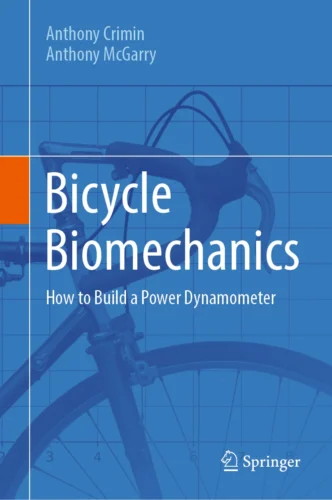By Charles Pekow — So how can you learn to bike more efficiently? Or understand the mechanics of just how your body’s interaction with the pedal machine actually moves you along? A new book provides answers and explains how you can adjust the vehicle to give your more power per revolution. The answer depends on what you want to use the bicycle for. The book discusses what to look for in buying a bike but mostly about adjusting it to your desired outcomes. The catch is, it’s hard to understand the very technical tome.

Bicycle Biomechanics: How to Build a Power Dynamometer discusses in very technical language the process of riding a bike and explains how to install a dynamometer so you can see how you’re doing. Dictionary.com defines dynamometer as “a device for measuring (either) mechanical force (or) mechanical power, especially one that measures the output or driving torque of a rotating machine.”
The book describes biomechanics as “the branch of science focused on the technique of objectively quantifying human motion or indeed that of any living animal.” To the book’s credit, it thankfully defines most of the technical terms.
The book, written by Anthony Crimin and Anthony McGarry — two scholars from the United Kingdom, explains how to go beyond the basic bicycle setup. The authors intend to help people at all levels from professionals to commuters, but the book is soo full of technical jargon and equations that only those in engineering or a related field and those who remember well their algebra will understand. Don’t read Bicycle Biomechanics for a thrill or humor. It even talks of “analytical analysis.”
But if you slog through it, you can learn some ways to try to ride more efficiently if you’ve got the knack to assemble a dynamometer. The book is loaded with charts, graphs and equations, such as:
The power (P) developed by the cyclist is calculated by taking the product of the moment (M) and crank angular velocity (Eqs. 5.12 and 5.13). The relationship between the number of crank revolutions per minute (rpm) and the angular velocity is shown by Eq. 5.14.
-
-
- (Eq. 5.12) M = crank length (l) x Feffective force
- (Eq. 5.13) P = Mω
- (Eq. 5.14) ω = 120π/rpm
-
And many are much more complicated. For example, sentences like “Markers are usually placed on identifiable bony prominences such as knee epicondyles, ankle malleolus, and the iliac crest of the pelvis—for both 2D video analysis and full 3D motion capture.” Whew!
The first chapter goes through the history and pre-history of modern bicycles, discussing their 19th Century forerunners (or should we say forecycles?). It starts out telling you that bicycles haven’t changed much in many ways over their history: pedals and handlebars remain in the same place. Changes in wheelbase, fork rake and trail have made bikes more adaptable to specific uses. For instance, racing bikes “have steeper steering angles (74°) compared to touring or audax geometry (72°) as more toe clearance is required for mudguards or panniers. This can affect the wheelbase and the ‘slacker’ head tube angle for non-racing machines and increases the wheelbase, which makes the frame less agile but provides greater straight-line stability.”
Lighter materials and design changes to improve aerodynamic have improved cycles over time. Tricycles, quadricycles and even hand-powered machines make cycling possible for some people. The book says that bicycles were developed in “tandem” with roller skates, which may have helped inspire people to believe in wheels under feet.
The second chapter discusses drag and aerodynamics. Just like outfits, racing bikes are tweaked to fit the racer, but most drag is caused by the rider. Weight, clothes and position don’t make much difference inside a car but affect your motion on a bike and the book explains why you can improve your efficiency with well-lubricated and maintained chains.
The book says that racers who break speed records do so largely because of design – it’s not just their strength or talent (or performance enhancing drugs, Lance Armstrong). Some racing bike designers focus on weight; others on drag resistance.
The lesson here for average cyclists is not to worry much about drag reducing unless you participate in races: “do not adopt super aerodynamic positions and think you will go faster, as there is also a compromise between comfort and ergonomics/flexibility to hold these positions.”
The third chapter focuses on design. It says AI tools, even on cellphones, can help riders position themselves to find optimum relationships, for instance, between motion and limb position, saddle height and knee flexion. The chapter discusses how to measure forces riders use. It recommends one specific tool, MyVeloFit, which can help your fit (http://myvelofit.com/pricing/rider/). You can also use your own cellphone camera.
Everything from the seat height to the tilt of the saddle and the height and length of the stem affects not just your legs, but the position of your elbows, and adjusting them can help find the right position for you. “By setting the saddle in a more forward position, it was found that more work was performed at the knee joint, along with reduced work at the hip,” we learn.
If you consider what to do with all the contact points and joints, you can reduce the load on your spine.
Chapter four covers “muscle physiology and force development,” with a formula to balance comfort and maximum power. The direction of the saddle nose can affect your speed. It makes a difference when going uphill because you use energy just to maintain a position on the saddle, if that doesn’t saddle you with too much detail.
A mathematical formula tells you how cadence and power relate, at what point power peaks, and how it varies with crank length, but the basic advice is just to optimize your comfort. The authors acknowledge that biomechanics and bike set-up won’t explain everything, as they don’t measure your muscle composition and aerobic and anaerobic capacities.
The final chapter tells you how to build a power dynamometer, fit it on your bike, and calibrate. You can choose from three different types: crank, bottom bracket force and pedals. And – it could get costly.
Since the authors come from Great Britain, some of the references differ from what you’d find in North America, but if you love technical reading, take racing seriously, or are willing to work to get a little more speed or energy efficiency, you might find the volume helpful.
Bicycle Biomechanics: How to Build a Power Dynamometer by Anthony Crimin and Anthony McGarry, 150 pages, is available as an ebook for $119 or hardbound at $159.99 from Springer Nature, link.springer.com/book/10.1007/978-3-031-85712-6.






